Alaska Fish & Wildlife News
March 2023
Placing Alaska Wildlife in Zoos
Homes are Hard to Find
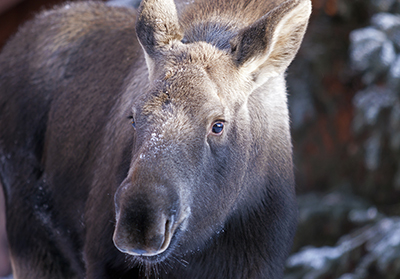
Two Kodiak bears are at home in a Wisconsin zoo and their brother is in Ohio. Orphaned as cubs in 2015, these three bears are a zoo-placement success story. But it’s far more difficult to place animals in zoos than people realize, and the devil is in the details.
“People think there are just automatically homes for orphaned animals, that’s a common misconception” said Patrick Lampi, the executive director of the Alaska Zoo in Anchorage. The Alaska Zoo has long been instrumental in the process of placing Alaska animals in facilities outside the state and works closely with Fish and Game.
Since adult wild animals do not adjust well to captivity, zoos typically only want young animals. And that’s part of the reason why few placements are available – these animals live for decades.
“If it’s a young orphan and it’s raised properly, so this (captive life) is what they know, it can work out,” Lampi said. “With bears, only cubs of the year would be considered for placement, and even that is subject to availability. Black bears are found in every state but Hawaii, and they are difficult to place.”
State wildlife biologist Stephanie Bogle has a list of dozens of zoos and wildlife education facilities throughout the Lower 48 and Alaska. Every spring she reaches out to learn what they want and what they can accommodate. Some complete the application process in advance so they are ready if an opportunity arises.
Some facilities are specialized – they just have bears, for example. Others, like zoos, can potentially take many kinds of animals – but they only want specific animals.
“It really varies year to year,” Bogle said. “I currently have a ton of facilities that want brown bears, and very few that want black bears. Porcupines - people love porcupines. Anything that’s really Arctic, Arctic fox, wolves, lynx – but those animals don’t come up very often. There are not currently many options for moose.”
She shares the updated list with biologists across the state in the spring, and encourages them to also call when any animal becomes available. She may have learned that another placement fell through, or a death at a zoo has unexpectedly opened up a spot.
“I try to exhaust all the options before we have to humanely kill an animal,” she said.
Taking the Wildlife Call
State wildlife biologists manage large areas and have a wide range of responsibilities. But if, for example, a mother brown bear has been hit by a vehicle and killed on the highway, and there’s a healthy orphaned cub on the scene, the area biologist will call Bogle.
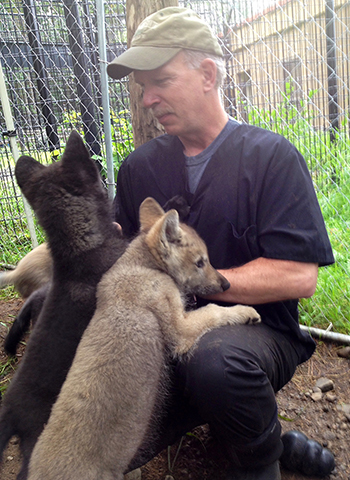
“First I see if the Alaska Zoo can serve as a temporary holding facility,” she said. “They are super helpful and do a ton of stuff for us: helping organize shipping, providing veterinary care if needed, and providing temporary housing until they’re able to send an animal to a facility.”
Animals are held for weeks and often for months before they can be transported. An animal might be malnourished and stressed, or injured and needs care before it’s healthy enough to be shipped. Some animals are not well suited to being drugged, crated and shipped across the country.
Sometimes animals must be accompanied during transport, or may need care during a layover. Lampi has stepped in to help when animals have stopped over in Anchorage.
“Last summer I was asked to check on pygmy hippos on their way from Asia to Florida,” he said. “They had a refueling stop in Anchorage. I was asked to go check on the hippos and feed and water them, with the USDA veterinarian. We sent them on their way, and they made it just fine.”
Weather is a big factor with shipping logistics.
“It might not be too hot in Alaska, but if we have to ship a moose to Ohio and it’s 95 degrees there – we just can’t do it,” Bogle said. “At least not at that time. And the Alaska Zoo only has a limited amount of space to temporarily hold an animal. There are a lot of moving parts that have to line up.”
“We won’t ship animals if any stop along the way is more than 80 degrees,” Lampi said.
That means an animal may be held at the Alaska Zoo for months, or even longer. “Many of the orphans that come in over the summer can’t be shipped until fall, because of conditions. We just have to wait.”
The zoo receiving the animal pays for its transport, but the Alaska Zoo bears the cost of feeding and caring for the animals at the zoo. “It can be a big cost, last year we had 18 orphaned animals, including moose calves and bear cubs,” Lampi said. “It’s expensive. They’re getting fed four to six times a day. That’s a lot of formula, food, husbandry care and staff time.”
Juggling animals between enclosures is tricky, and a number of years ago the Alaska Zoo built an area specifically designed to temporarily house bear cubs. “It had been like musical chairs, switching animals around,” Lampi said.
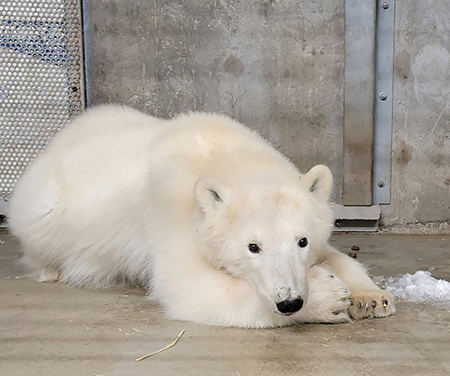
The cub facility is currently home to a young black bear that arrived in late September, extremely small and underweight. He will be leaving for his permanent home in Texas in March.
The Alaska Zoo received an orphaned polar bear in late November, which is being held in quarantine at the zoo’s polar bear maternity complex. The Alaska Zoo recently was issued a ‘Letter of Agreement’ from the US Fish & Wildlife Service for long-term holding and care of the cub. (Polar bears are managed by the US Fish and Wildlife Service, not State Fish and Game).
“He was seen eating an Arctic fox, and had some lacerations on his face, presumably from that fox, so he is in a six-month quarantine. He hasn’t shown any indications of rabies, and we’re feeling really good about it. Seems likely it’ll work out.”
The zoo already has one polar bear, a female named Cranberry, which was acquired from the Denver Zoo. The polar bear area was expanded in recent years and has plenty of room.
“The plan is for them to co-exist,” Lampi said. “We suspect with this being a younger bear they will acclimate together. We’ll do gradual introductions and make them comfortable. We rotate them in and out of an area to get them used to each other’s smell. Then we do an introduction through the bars first to prepare them, an area called ‘howdy doors’ where they see each other and get used to each other, but they can’t reach out and hurt each other.”
He said the initial in-person physical meeting is always a little nerve-racking. “We’re prepared with dart guns, fire extinguishers and water hoses, but we’ve never had to intercede,” he said.
Lampi said the Alaska Zoo kept four of the 18 animals they received last year, including a porcupine, an ermine, a Sitka black-tailed deer fawn, and a ground squirrel. The rest were placed in other zoos.
Appropriate facilities
State and federal laws determine what constitutes an appropriate facility for animals. And state laws regarding captive wildlife vary widely. The days may largely be over for “roadside attractions,” where animals such as bears were kept in cages outside restaurants and gift shops, but the standards in one state may be unacceptable to another – and to federal agencies.
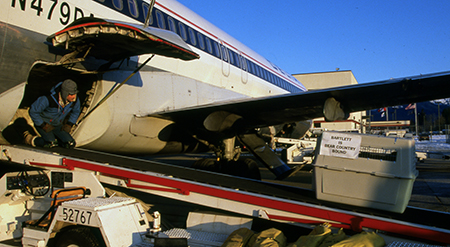
“One of the things I’ve run into is the public doesn’t like hearing no,” Bogle said. “People will take it on themselves to start calling around and asking places if they can take an animal – and we’ve already put a lot of effort into that.”
This creates an awkward situation for everyone. The concerned citizen often does not understand the situation with the animal, what constitutes an ‘appropriate’ facility, and may not convey the correct information to the correct person answering the phone. And someone at a zoo saying, “Have Fish and Game call us,” isn’t really a “yes.”
“Many places might say yes to the public, but they’re not approved and really can’t do it,” Bogle said. “I’ll get a message from a facility, ‘we got a call…’ and I already know about it and it’s not a situation that’ll work.”
A passion for a pet
While Bogle makes calls to place animals, she also receives a lot of calls from people who want wild animals as pets. It is not legal to capture and keep a wild animal as a pet, but it happens. Wildlife biologists and wildlife troopers have plenty of stories of deer, bears, porcupines, and lynx being kept as pets. People have also created major problems by regularly feeding wild animals like bears and moose (also illegal) and habituating them to people, and these stories don’t end well.
“We get a lot of requests,” Bogle said. “People just want animals. You can’t just have an animal because you want one. I recently got a request from a woman in the Lower 48 who wanted a black bear cub to take to schools for education. Like on a leash. I said, ‘what are you going to do when it grows up?’ That’s not something we’re going to do. People think their love is enough, their passion for animals. They mean well, but even if you’re a biologist, even if you have the knowledge, you have to have the space and the capabilities to actually take care of it.”
When the stars align
Timing and circumstances worked out for three Kodiak bears. In May of 2015, a hunter on Kodiak Island killed a female brown bear, not realizing she had cubs of the year in a den. Kodiak area biologist Nate Svoboda was contacted and he arranged retrieval of the three cubs.
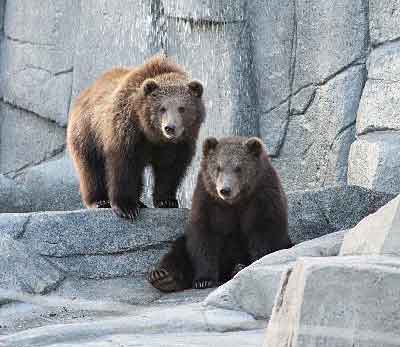
Fish and Game often receives reports of “orphaned” animals that are not orphaned, but temporarily unattended, and those animals should be left alone. Svoboda knew that was not the case in this situation, and that their prospects were dim. He was aware that placement was available and recognized the unusual opportunity to share Kodiak bears.
A brown bear is a 30-to-40-year commitment. Fortunately for two of the cubs, the Wildwood Park and Zoo in Marshfield, Wisconsin, was able to make that commitment. The zoo’s previous grizzly bear had died at 40 years of age - after 36 years at the zoo. The facility had been pre-approved and was putting the finishing touches on an upgraded and enlarged bear exhibit area. The third cub was placed in the Toledo Zoo and Aquarium in Ohio.
The cubs were cared for at the Alaska Zoo in Anchorage until their transfer to Wisconsin. All three bears adjusted and thrived.
“They are doing great,” said Sarah Storandt, manager of the Wildwood Park and Zoo, in a mid-February interview. “Their birthday is coming up in two weeks, they will be 8-years-old this year, and we’re throwing them a little party.”
The bears are very popular, she said. They have a large, wooded enclosure divided into two areas, connected by a bridge, that includes a pond and a deeper swimming area with a waterfall. “They are super smart,” she said. “They really enjoy different training, and all the toys we provide.”
Storandt said the bears do not hibernate, but they do slow down their activity quite a bit in winter. They are also very large.
“Boda is almost 1,300 pounds, he’s huge, and the little one is about 1,050 pounds. We wondered about Boda being so big. They have a third brother, he’s in Ohio, and we contacted them recently to see how big he is. He’s Munsey’s size, so Boda really is huge.”
More on finding and reporting stranded or "orphaned" animals
Riley Woodford is the editor of Alaska Fish and Wildlife News and produces the Sounds Wild! radio program.
Subscribe to be notified about new issues
Receive a monthly notice about new issues and articles.
